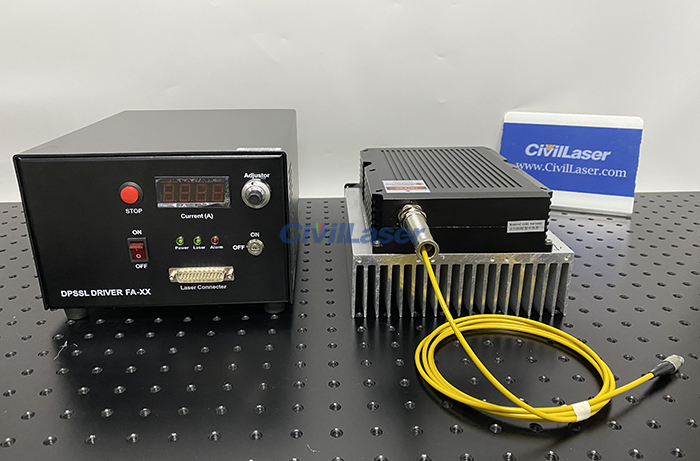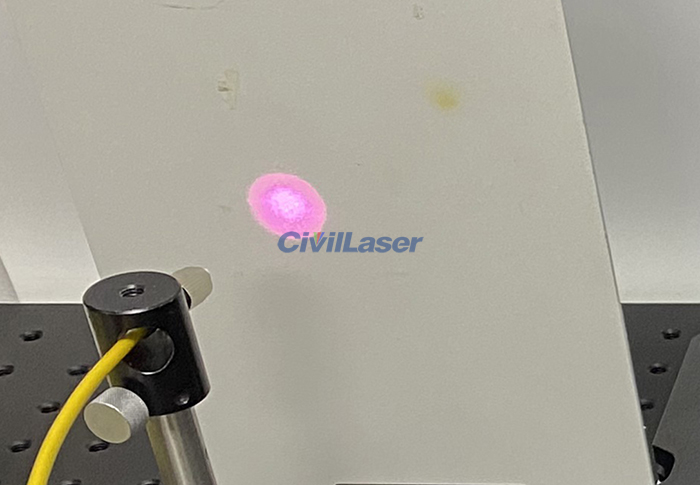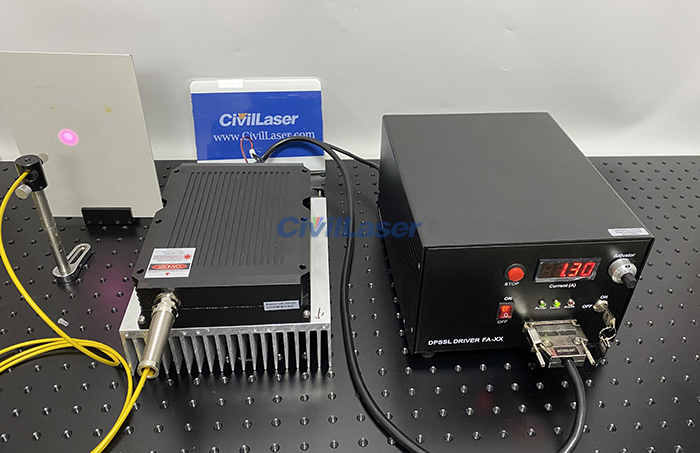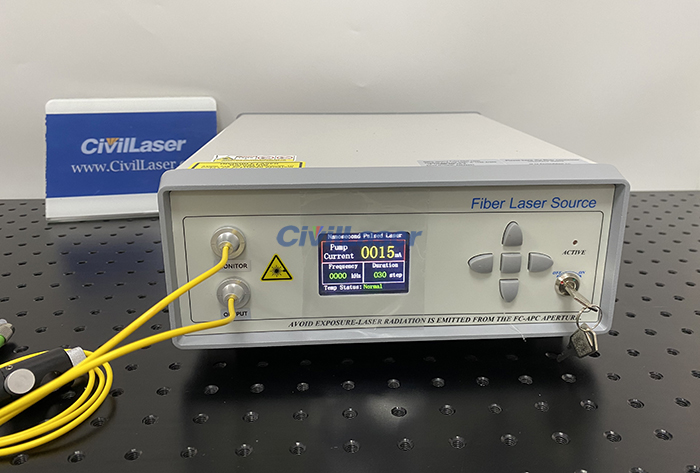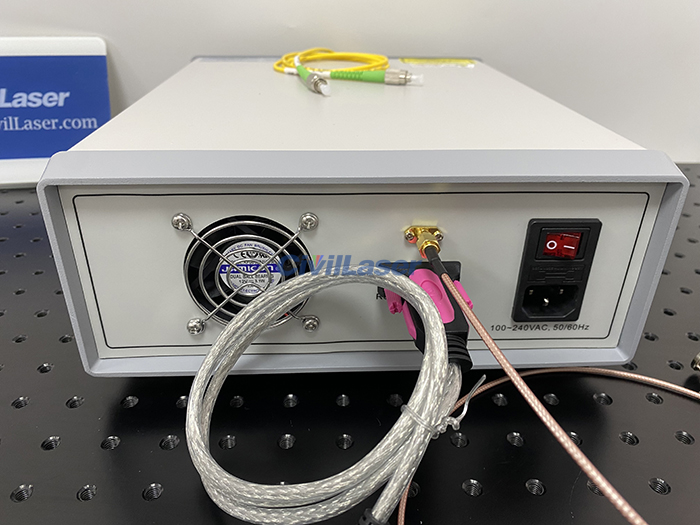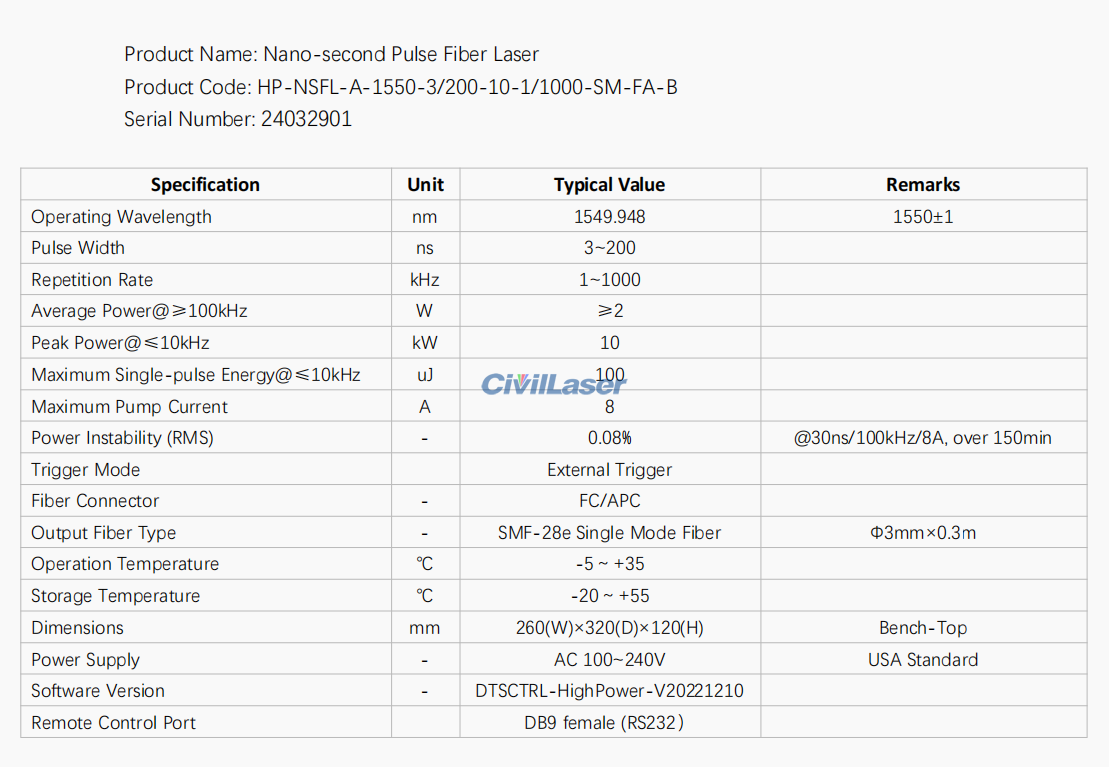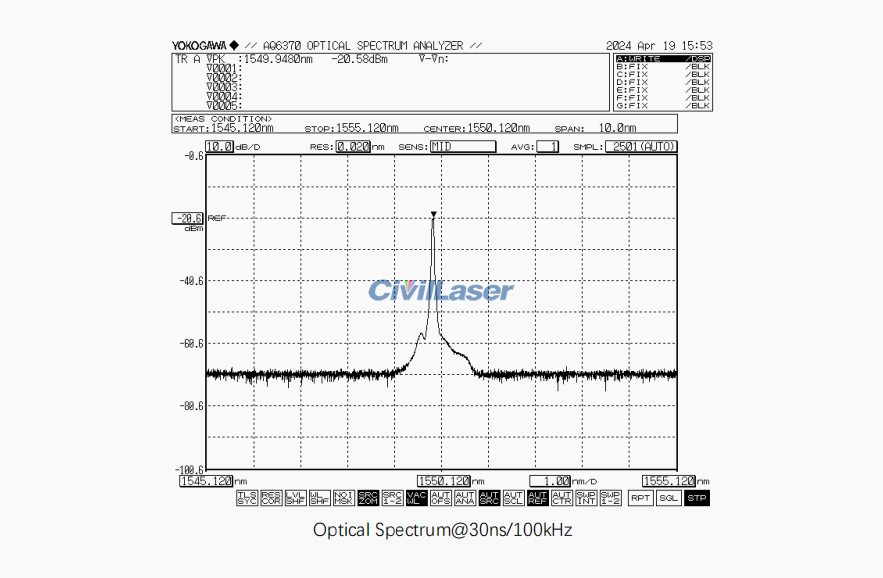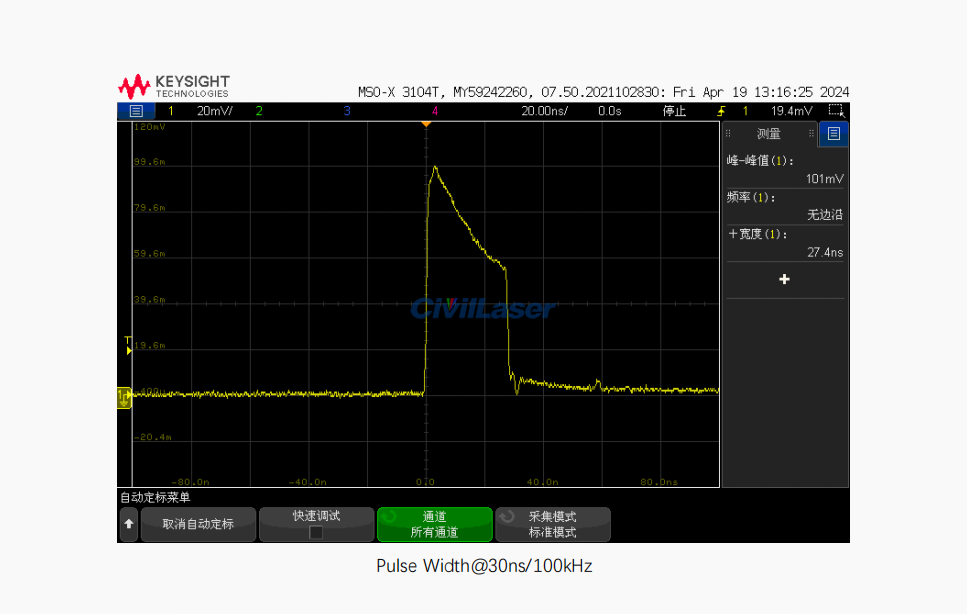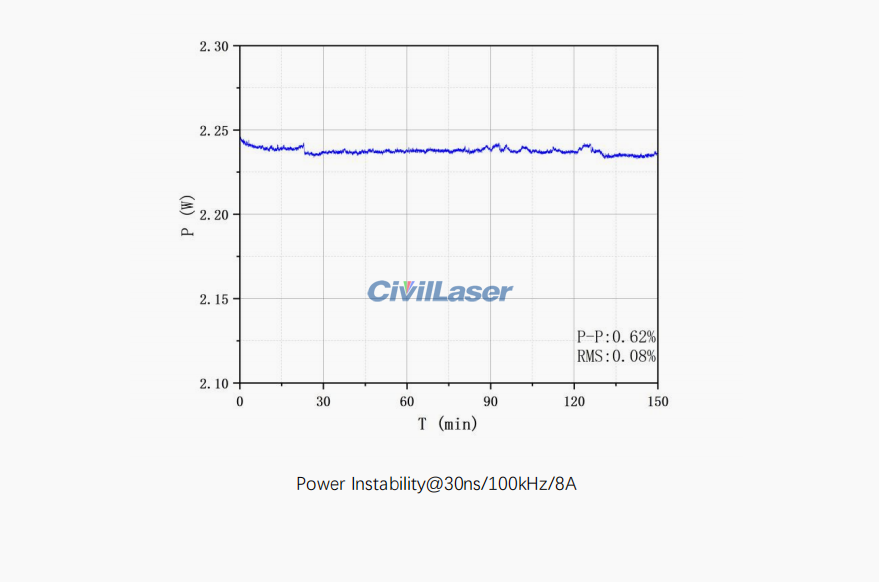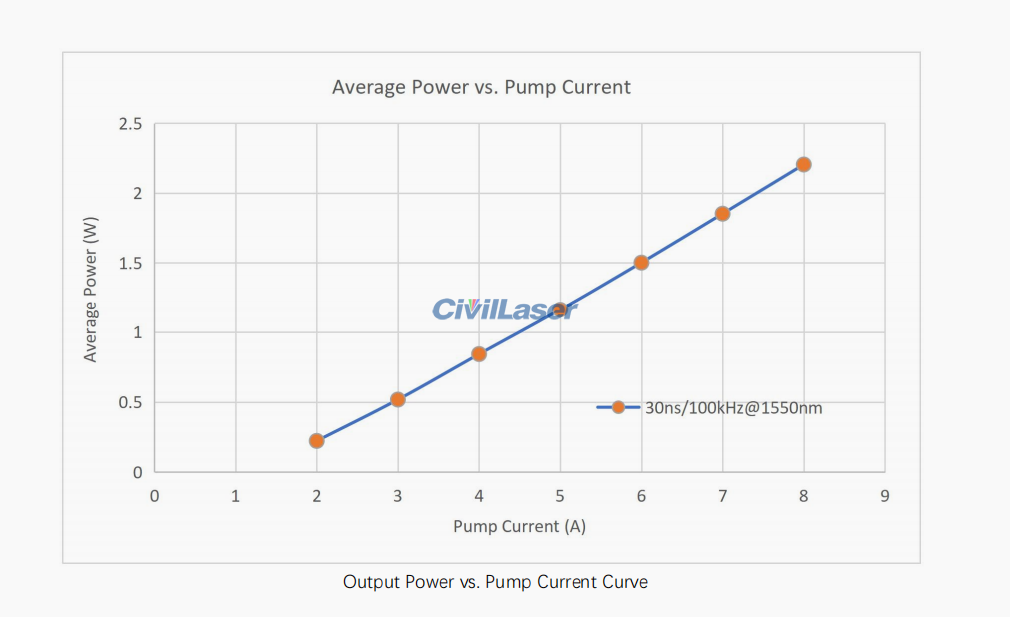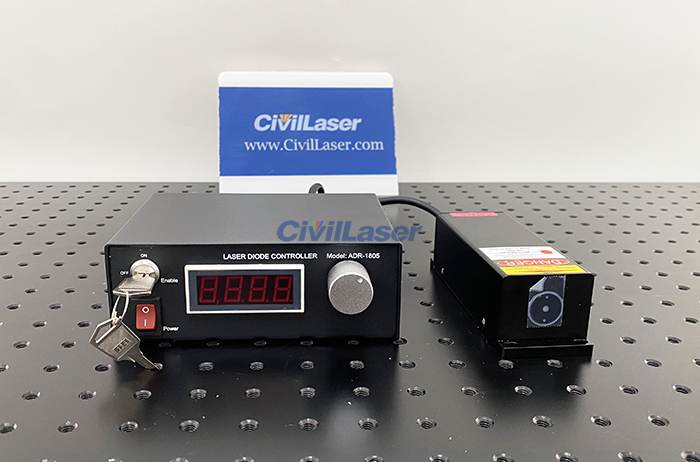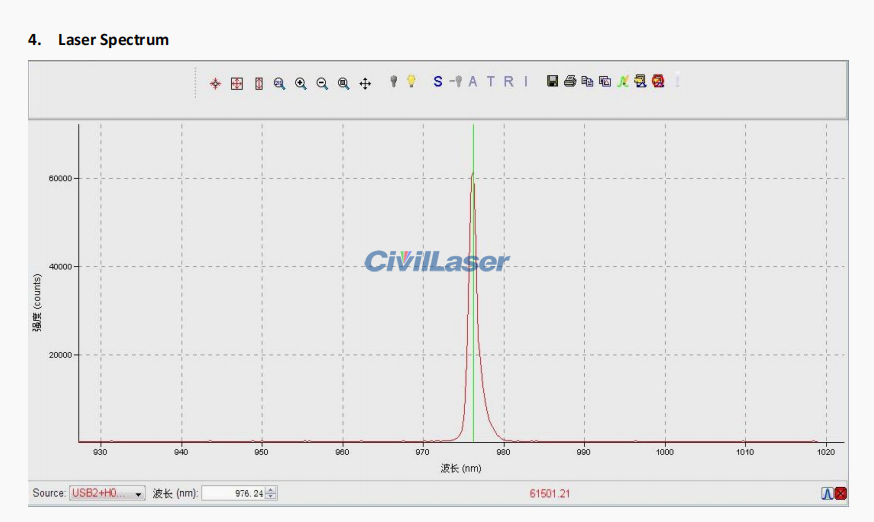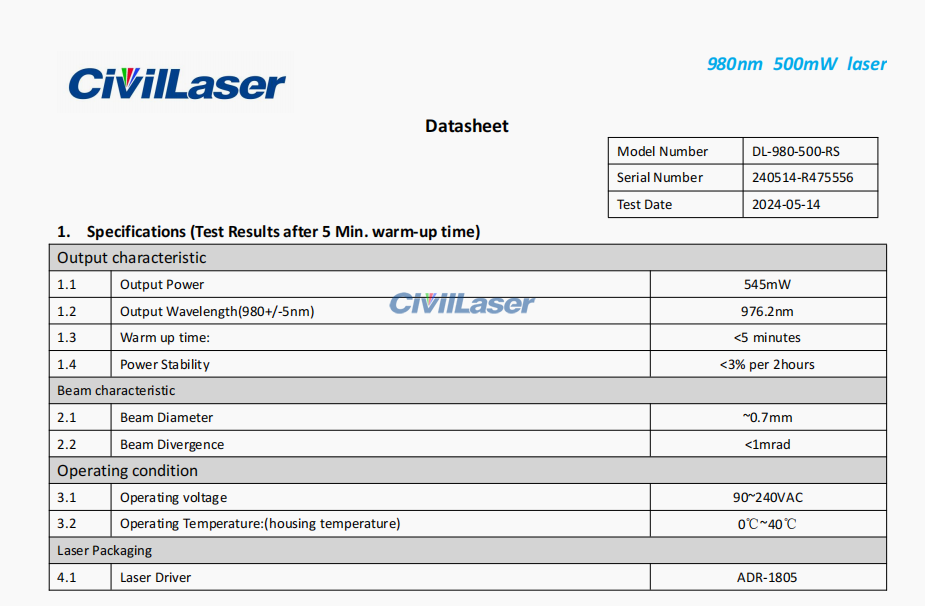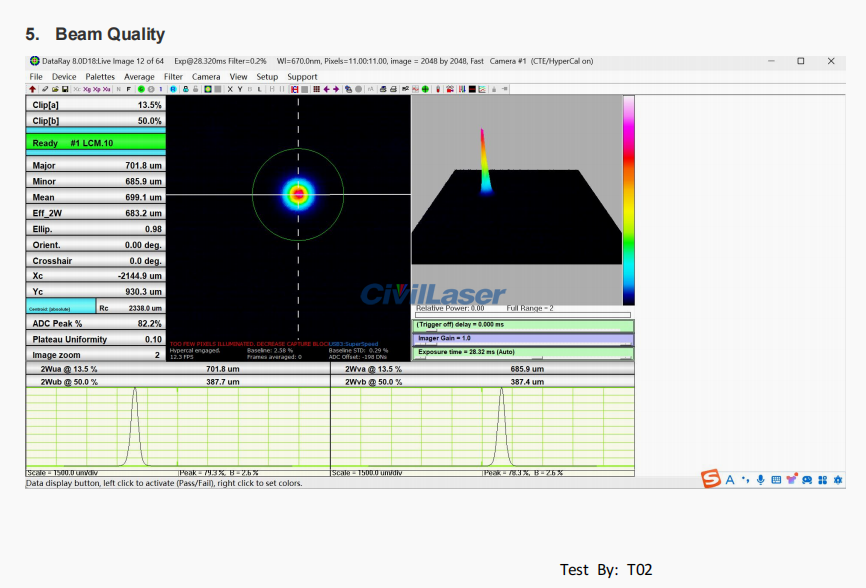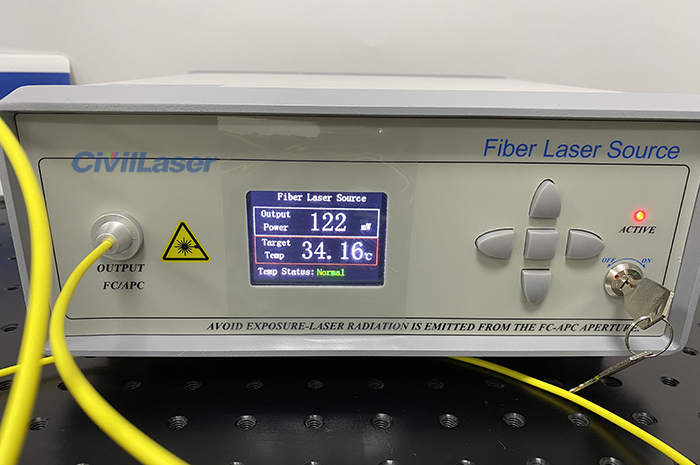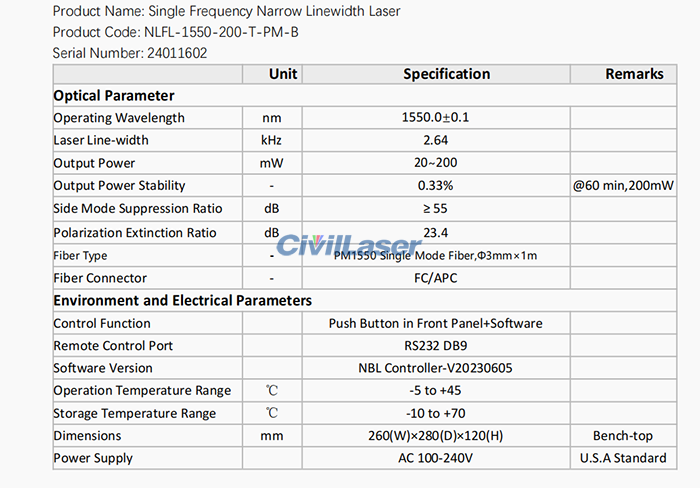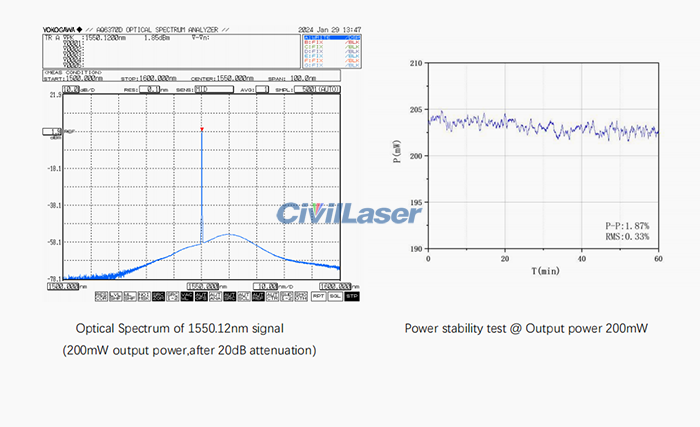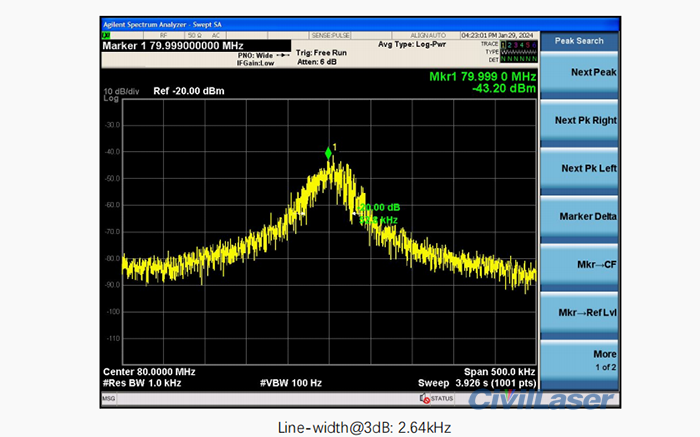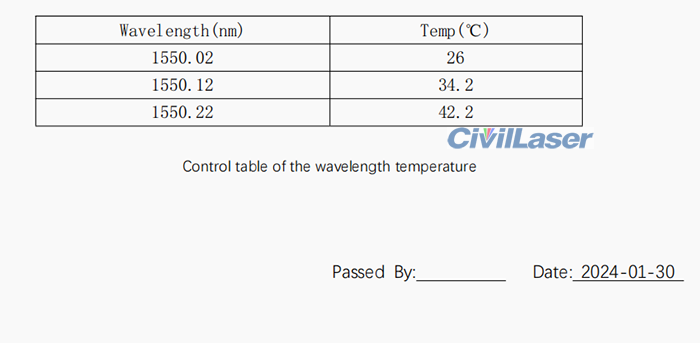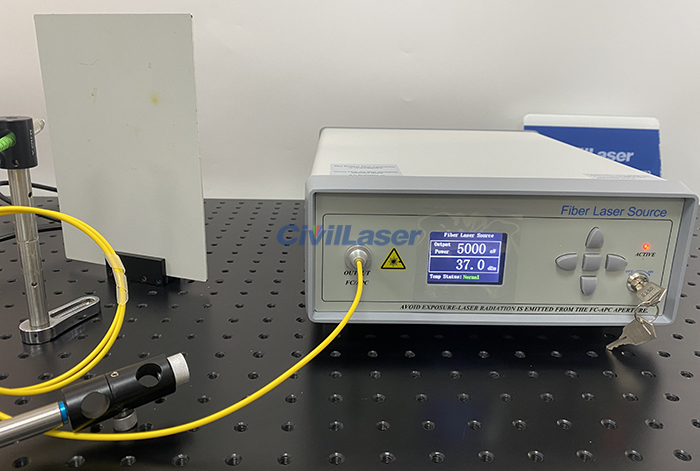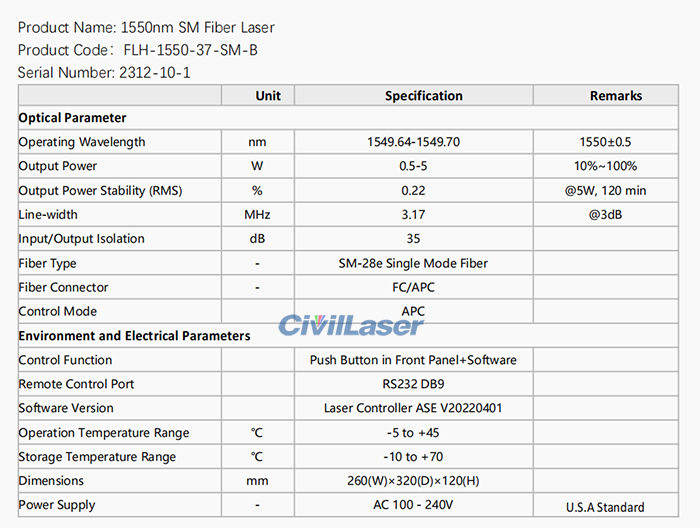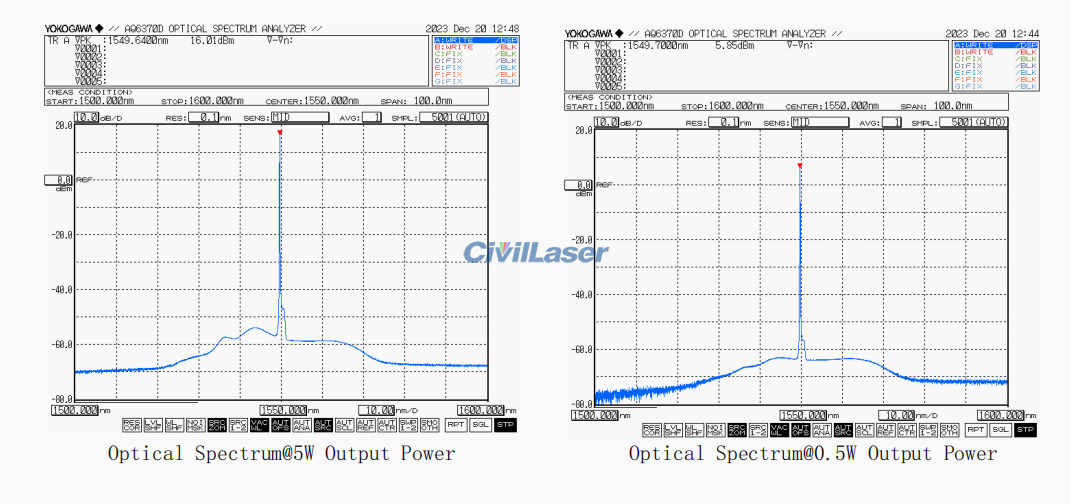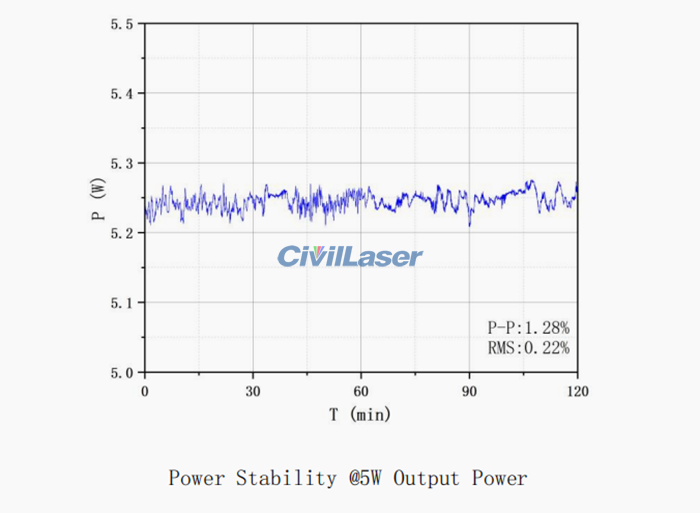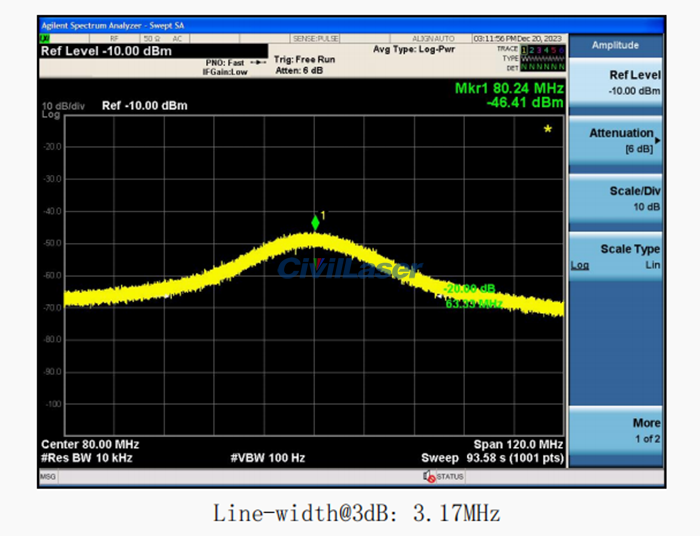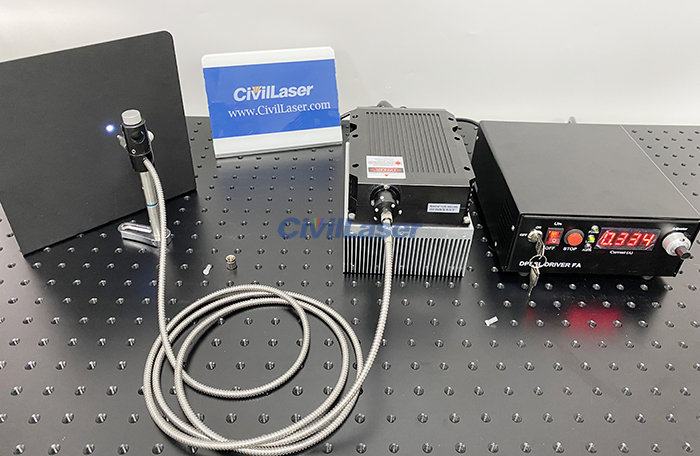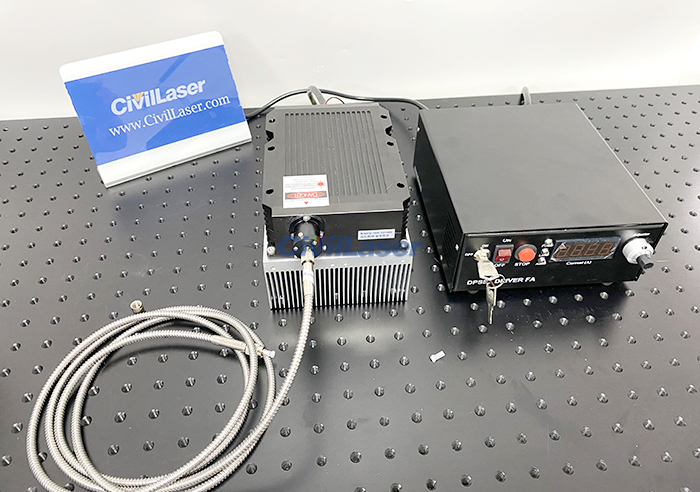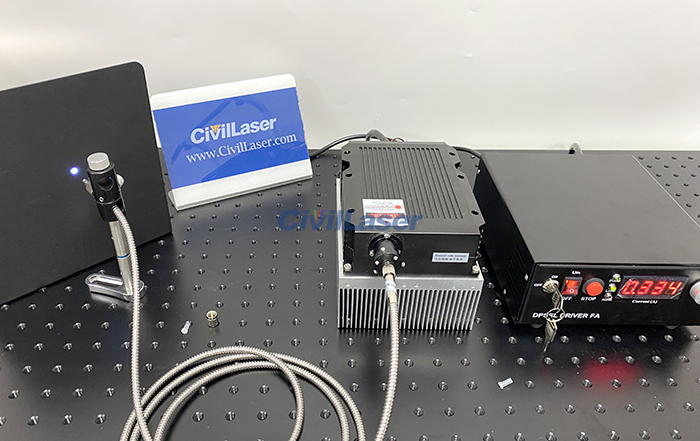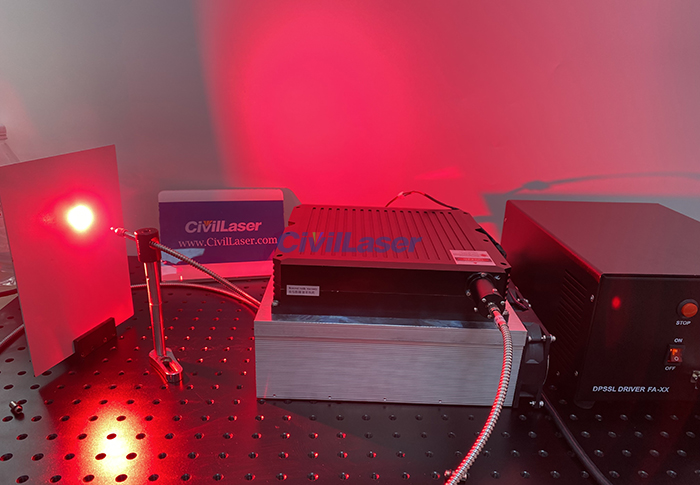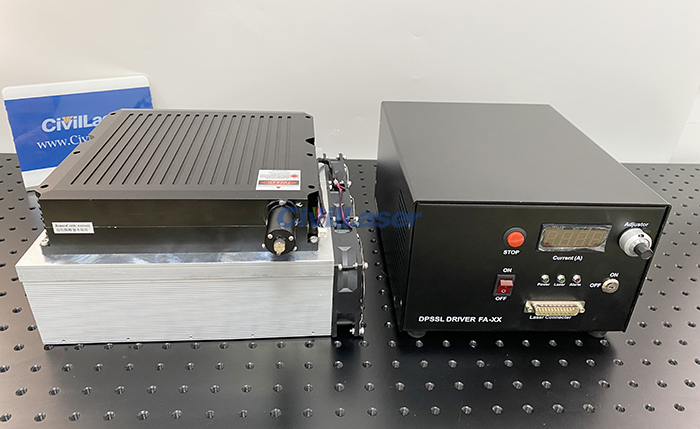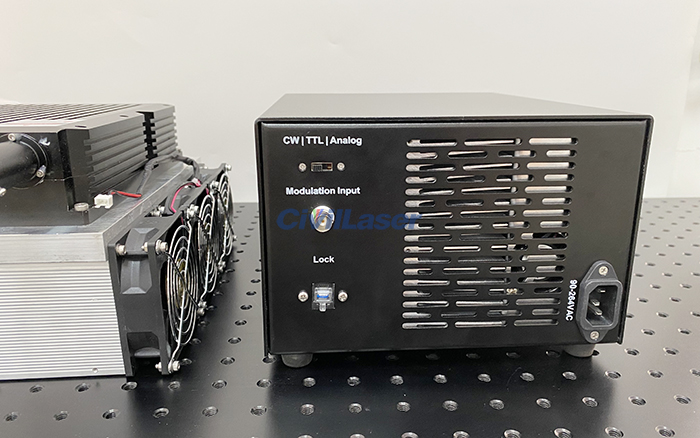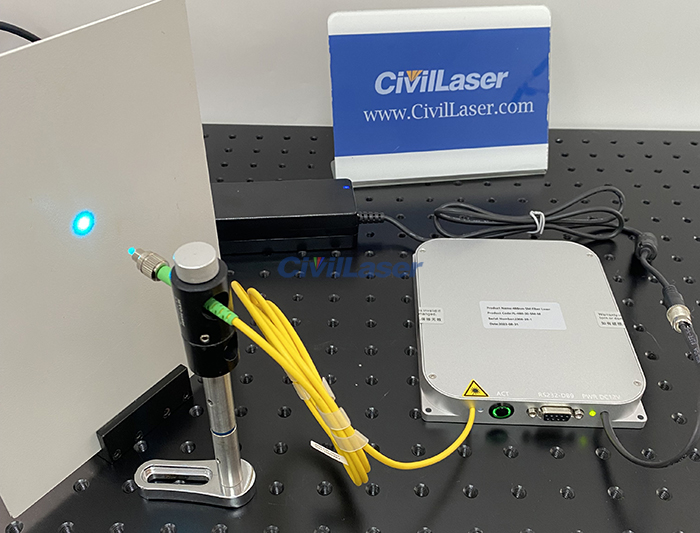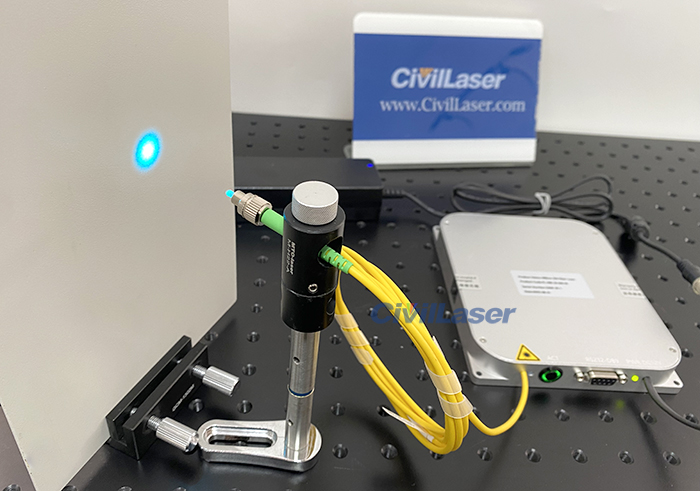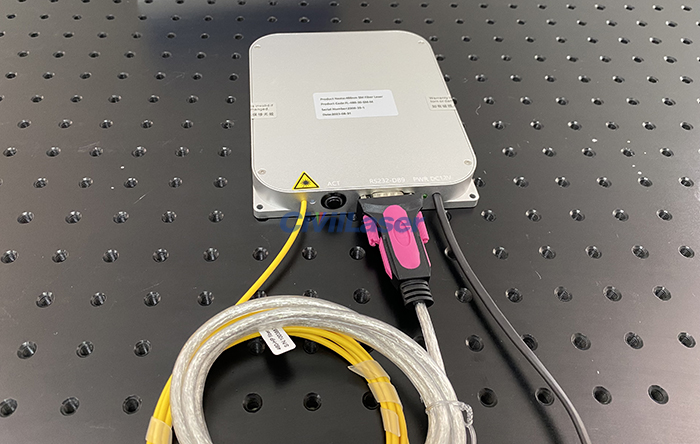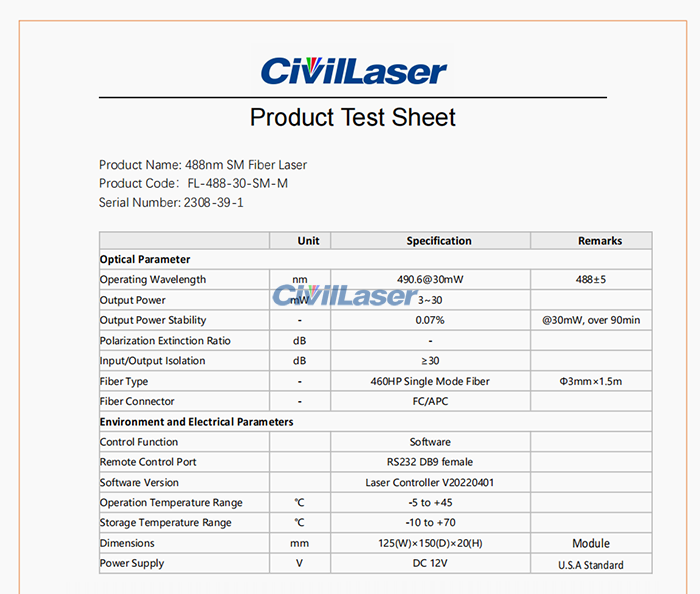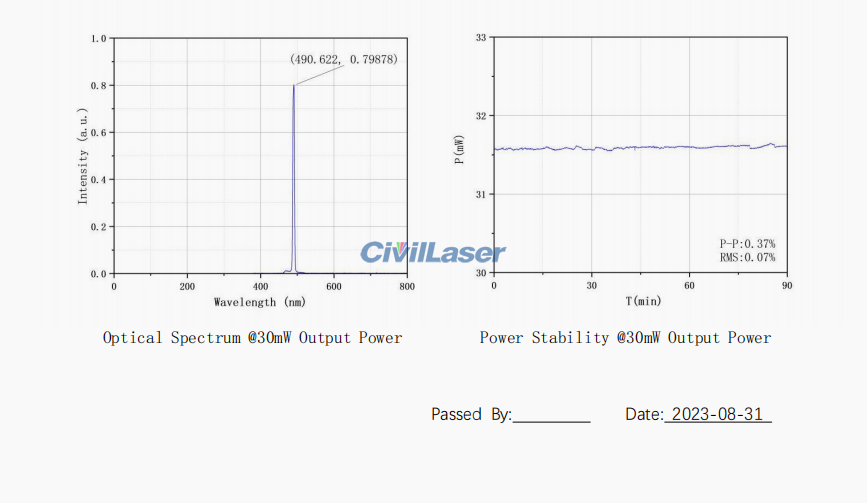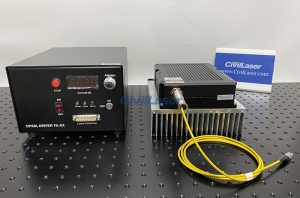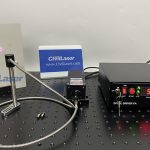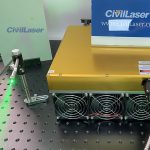Tag Archives: lab laser system
CivilLaser’s 808nm 70W High Power Fiber Laser
Today we will introduce an 808nm 70W high-power fiber-coupled laser. The laser module generates a lot of heat. A heat dissipation module is installed at the bottom of the laser module, equipped with 3 cooling fans. When connecting the laser module and the laser power supply, there is a small white interface on the data cable, which is used to power the cooling fan and needs to be connected. The fiber is a 400um high temperature resistant fiber. One end of the fiber is fixed on the laser. The fiber coupling efficiency is about 85%, and the output power at the fiber end is 59W. Before turning on the machine, please wear infrared laser protective glasses.
The 808nm laser is an infrared laser. It is very weak when viewed with the naked eye, but the light spot can still be clearly captured with a camera.
In the field of modern scientific research, fiber lasers have become an indispensable and important tool. Choosing a fiber laser with stable performance and support for customization is crucial to the accuracy and innovation of scientific research results. In this regard, CivilLaser’s fiber lasers are undoubtedly the first choice of many scientific research institutions.
CivilLaser has many years of experience in laser R&D and manufacturing, and its fiber lasers are known for their excellent performance and stability. Whether used for high-precision experiments or long-running complex tests, CivilLaser’s fiber lasers can always maintain efficient and stable output, providing reliable data support for scientific researchers.
In addition, CivilLaser has a deep understanding of the diverse needs of scientific research work and provides flexible customized services. Whether it is wavelength, power, or interface design, CivilLaser can tailor solutions according to users’ specific needs to help scientific research institutions better achieve experimental goals.
It is worth mentioning that CivilLaser’s fiber lasers have been widely used by many well-known scientific research institutions around the world. Its products are not only leading in technical performance, but also win the high trust of users with high-quality after-sales service.
If you’re looking for a reliable, customizable, industry-proven fiber laser, look no further than CivilLaser. We are committed to providing excellent fiber laser products to scientific researchers around the world and working with you to promote scientific progress.
1085nm 2W IR DPSS Laser Coupled Fiber Output
Today our laboratory tested a 1085nm 2W infrared fiber-coupled laser. There are 3 working modes to choose from: CW/TTL/Analog on the back of the power supply.
The laser head and power supply are labeled with model numbers. Please check whether the model numbers are consistent.
1085nm is an infrared laser, and the spot is invisible to our naked eyes. The light spot can be captured by the camera. We can also use an infrared detection card to observe the laser spot. Through the sponge test, we can see that its power is high and smoke will come out when touched.
385nm 180mW Lab Laser System Operation Video
385nm semiconductor lasers are based on the photoelectric effect of semiconductor materials. They use electrical excitation to make electrons in semiconductors transition and release light energy, thereby generating lasers. Its working material is semiconductor material, which has the advantages of small size, light weight, high efficiency, and long life. By optimizing the design of the resonant cavity, the 385nm 180mw laser can provide a near-Gaussian distributed beam with concentrated energy and high beam quality. In the field of scientific research, 385nm semiconductor lasers can be used for experiments such as spectral analysis, laser holography, and cell sorting, providing precise light source support for researchers.
This 385nm 180mW semiconductor laser. There are three working modes of CW/TTL/Analog on the back of the power supply to choose from. Rotate the ‘Adjustor’ knob on the power supply to adjust the current and thus the laser output power. This is the free space output mode, customizable for fiber coupling.
We observe the 385nm spot on the black background plate.
385nm semiconductor lasers have the advantages of stable wavelength, adjustable output power, and high beam quality. They have broad application prospects in the fields of ultraviolet curing, scientific research experiments, and industrial applications.
Innovative Progress of 10kW Pulsed Nanosecond Fiber Laser in 1550nm Band
1550nm nanosecond pulse laser system. This high-power nanosecond laser is equipped with 2 fibers. The Ouput fiber below is the normal laser output fiber. The Monitor fiber above is a signal synchronization fiber, used for synchronizing optical signals, with a peak power of about 10mW. The signal can be built-in or external input. The yellow interface here is the signal input interface. This laser uses an external signal. You can only control the current through the button, but not the signal frequency. Let’s check it now.
The pulse width is adjustable from 3 to 200 ns, and the repetition frequency is adjustable from 1 to 3000 kHz.
The laser can be controlled via buttons. It can also be controlled through software, via RS232-USB and PC software link.
The is a shining star in modern industrial technology. Its high power output and precise nanosecond pulse control make it an ideal choice for material processing, scientific research experiments and other fields. With its unique fiber structure, this laser achieves high efficiency, long life and stability, bringing revolutionary changes to industrial production. In the future, it will continue to lead the new trend of laser technology and contribute to scientific and technological progress and industrial development.
The test data of 1550nm nanosecond high-power laser.
Technical Characteristics and Application Fields of 980nm 500mW TEM00 Laser
In today’s laser technology field, the 980nm 500mW TEM00 semiconductor laser has become the focus of scientific researchers and technicians with its unique optical properties and wide application prospects. This laser provides strong technical support for research and applications in many fields with its high-precision and high-efficiency laser output.
The working wavelength of this laser is set at 980nm, which is a wavelength in the infrared spectrum and has excellent penetration capabilities into biological tissues, so it has extremely high application value in the biomedical field. For example, in photodynamic therapy, laser surgery and fluorescence imaging, 980nm laser can effectively penetrate biological tissue and achieve precise treatment or observation of deep tissue. The laser power is adjustable from 0~500mW. It supports CW & TTL two working modes.
More importantly, this laser uses TEM00 mode output, the spot size is about 0.7mm. TEM00 mode means that the transverse electric field and magnetic field distribution of the light spot are both zero-order modes, that is, the light spot is the fundamental mode distribution, the spot size is uniform, and the energy is concentrated. This mode of laser has extremely high beam quality and stability, ensuring that the laser maintains a small divergence angle and high energy density during transmission and focusing, thereby achieving more precise laser processing and measurement.
To sum up, the 980nm TEM00 semiconductor laser has become a shining pearl in the field of laser technology today with its unique optical properties and wide application prospects. Whether in the fields of biomedicine, materials processing or scientific research, it has shown strong application potential and value.
1550nm 3kHz Linewidth PM Fiber Laser Source Benchtop
Single frequency narrow linewidth fiber laser adopts rare earth doped fiber DFB laser cavity structure, output single longitudinal mode laser with wavelength of 1550nm, spectral linewidth is less than 3kHz, output spectral side mode suppression ratio exceeds 60dB.
What we demonstrate in the video is a 1550nm 200mW narrow linewidth fiber laser with a linewidth of 2.64kHz. The output optical fiber is available in SM/PM, here is the PM optical fiber. And it is fixed on the laser and is not pluggable. The optical fiber interface and length can be customized.
The laser output power can be adjusted through the button, the adjustment range is 10%~100%, and the adjustment accuracy is 1mW. The working Temperature can be fine-tuned, which can affect the laser wavelength. The adjustment accuracy is 0.01℃. The laser can also be controlled through software, and the interface on the laser is RS2023.
Parameter table of 1550nm narrow Linewidth Laser.
1550nm 37dBm 5W High Power SM Fiber Coupled Laser
What our laboratory demonstrates today is a 1550nm 37dBm IR laser coupled singlemode optical fiber output. The output power is adjustable with an adjustment range of 0.5~5W. The adjustment accuracy is 1mW. The Line-width here is 3.7 MHz, and the line width of 1MHz can be customized. The laser can be controlled through the buttons on the panel to adjust the laser output power. 1550nm is infrared invisible light, and the light spot can be observed with an infrared sensor plate. Let’s check it now.
This laser adopts DFB type laser chip, and cooperates with high-power gain optical path module to realize single-mode fiber output of single-wavelength high-power laser. The professionally designed drive and temperature control circuit control ensures the safe and stable operation of the laser, and the spectrum and power remain stable for a long time. The modular package has a compact structure, which is convenient for user system integration and is more suitable for engineering applications.
What is configured here is single-mode fiber, and polarization-maintaining fiber can be customized. The laser can also be controlled through software, and the communication interface is RS232. The following is the interface for the control software.
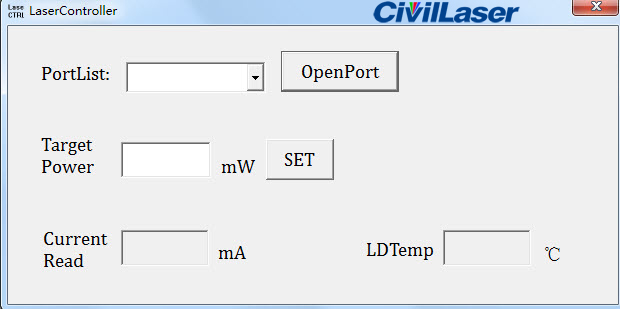
The power switch is on the back of the laser.The LCD panel displays the laser output power. Turn the key to ON, the laser is activated, and the Active indicator lights up.
Use the left and right buttons to select the number position to be adjusted (units, tens, hundreds, thousands). The up and down buttons adjust the value. The middle button is the confirmation key.
These are laser test reports, including the main parameters of the laser, spectrum diagram, power stability test, and line width test results.
395nm 2W UV Laser Source Fiber Output
This is 395nm 2000mW UV laser source system. The laser module with radiator on the bottom and the radiator includes 2 cooling fans. When the laser is working, the operating current is displayed on the laser power supply, and the laser output power can be adjusted by rotating the button. 395nm is a near-ultraviolet laser, and a weak blue-violet light spot can be seen on the light shielding plate. Let’s check it now.
As can be seen from the video, this is a fiber optic coupling device, which is a multi-mode fiber and the fiber is pluggable. The coupling optical fiber can be customized. The one used here is 100μm, 2m in length, and the interface is FC/PC. There is a buckle on the interface. When installing the optical fiber, insert the optical fiber into the buckle and tighten it.
40W 637nm Powerful Fiber Laser System Operation Video
This is a 637nm 40W powerful lab fiber coupled laser system. The laser module includes a radiator. The laser power supply has a current display and the ‘Adjustor’ knob can adjust the laser output. The three working modes of CW/TTL/Analog can be switched on the back of the power supply.
When no optical fiber is installed, the light spots are scattered. The optical fiber used here is 600μm, SMA905 interface. The high power red laser beam from the fiber port. Let’s check it now.
488nm Single-mode Fiber Laser System Module Type
Today we bring a 488nm single-mode fiber laser module. This laser adopts semiconductor laser chip, and the professionally designed drive and temperature control circuit temperature control ensures the safe operation of the laser, stable output power and spectrum, and excellent spot quality (TEM00 mode).
This is a modular structure, and the desktop model can also be customized. The laser output power can be adjusted, and the adjustment range is 10% ~ 100%. The laser can be controlled by software, connected to the computer via RS232-USB.
The fiber here is single-mode, and polarization-maintaining fiber can also be customized.
Datasheet of actual measurements of the laser.
The spectrum diagram and power stability test diagram of the laser.







